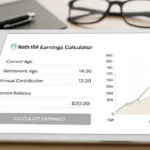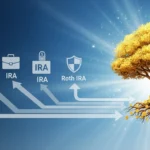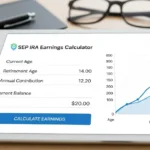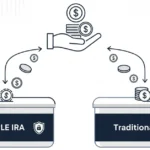Many individuals looking to diversify their retirement portfolios are exploring alternative assets like precious metals. Gold, in particular, has long been considered a safe haven asset, offering a hedge against inflation and economic uncertainty. This leads to a common question: Can I Transfer My 401k to a Gold IRA?
The short answer is yes, generally you can, but it’s not a direct transfer in the traditional sense. Instead, it typically involves a rollover. Understanding the nuances of this process, the rules involved, and the potential benefits and drawbacks is crucial before making any decisions. This comprehensive guide will walk you through everything you need to know about moving your retirement savings into a Gold IRA.
What is a Gold IRA? : Can I Transfer My 401k to a Gold IRA?
A Gold IRA, or precious metals IRA, is a self-directed individual retirement account that allows you to hold physical precious metals like gold, silver, platinum, and palladium. Unlike traditional IRAs that typically hold paper assets like stocks, bonds, and mutual funds, a Gold IRA allows for the tangible ownership of these metals.
Key characteristics of a Gold IRA include:
- Self-Directed: You have more control over the investment decisions, specifically choosing which precious metals to include.
- Custodian Required: The IRS mandates that all IRA assets must be held by a trustee or custodian. This specialized custodian handles the administrative tasks, reporting, and ensures compliance with IRS regulations.
- Storage Requirements: Physical precious metals held in a Gold IRA cannot be stored at home. They must be held in an IRS-approved depository.
- Tax Advantages: Like traditional IRAs, contributions may be tax-deductible, and earnings grow tax-deferred. Roth Gold IRAs offer tax-free withdrawals in retirement, provided certain conditions are met.
Understanding the 401(k)
A 401(k) is a retirement savings plan sponsored by an employer. It allows employees to contribute a portion of their pre-tax salary, and in many cases, employers offer matching contributions. The funds in a 401(k) typically grow tax-deferred until retirement.
Key features of a 401(k) include:
- Employer-Sponsored: Offered through your workplace.
- Pre-Tax Contributions: Contributions are usually made before taxes are deducted, reducing your current taxable income.
- Potential Employer Match: Many employers match a certain percentage of employee contributions, essentially providing “free money” towards retirement savings.
- Limited Investment Options: Investment choices within a 401(k) are typically selected by the employer and may include mutual funds, ETFs, and target-date funds.
- Withdrawal Restrictions: Generally, withdrawals before age 59 ½ are subject to taxes and penalties, although there are some exceptions.
The Process of Moving Your 401(k) to a Gold IRA: The Rollover
As mentioned earlier, transferring your 401(k) to a Gold IRA isn’t a direct transfer. It involves a process called a rollover. There are two main types of rollovers:
- Direct Rollover: In a direct rollover, your existing 401(k) custodian directly sends the funds to your new Gold IRA custodian. You never have direct access to the money, which helps avoid potential tax implications.
- Indirect Rollover: In an indirect rollover, you receive a check from your 401(k) plan. You then have 60 days to deposit these funds into your new Gold IRA. While this offers more flexibility, it also comes with the risk of missing the 60-day deadline, which could result in the distribution being treated as a taxable withdrawal with potential penalties. Additionally, your 401(k) provider is required to withhold 20% for taxes in an indirect rollover, which you’ll need to make up when you deposit into your Gold IRA to avoid taxes and penalties on the full amount.
It is generally recommended to opt for a direct rollover to avoid potential tax complications and penalties.
Here’s a step-by-step guide to the rollover process:
- Choose a Gold IRA Custodian: This is a crucial step. You need to select a reputable custodian that specializes in holding precious metals. They will guide you through the setup process and ensure compliance with IRS regulations. Research different custodians, compare their fees, storage options, and reputation. Companies like Augusta Gold IRA have built a strong reputation in the precious metals IRA space, known for their customer service, educational resources, and streamlined rollover process. Their expertise can be invaluable in navigating the complexities of transferring your retirement funds into physical gold. Click here to learn more about Augusta Gold IRA and how they can assist with your Gold IRA rollover.
- Open a Gold IRA Account: Once you’ve chosen a custodian, you’ll need to complete their account opening paperwork. This will involve providing personal information and details about your existing 401(k) account.
- Initiate the Rollover with Your 401(k) Administrator: Contact your current 401(k) plan administrator and inform them of your intention to perform a rollover to a Gold IRA. They will provide you with the necessary forms and instructions. Specify that you want a direct rollover to your chosen Gold IRA custodian.
- Coordinate with Your Gold IRA Custodian: Your new custodian will work directly with your 401(k) administrator to facilitate the transfer of funds. They will provide the necessary transfer instructions and ensure the process is handled correctly.
- Select Your Precious Metals: Once the funds are in your Gold IRA, you can decide which precious metals you want to purchase. Your custodian can help you with this process, offering guidance on IRS-approved metals and reputable dealers.
- Secure Storage: Your purchased precious metals will be securely stored in an IRS-approved depository. You will typically have options regarding the location and type of storage, although your custodian will handle the logistics.
Considerations Before Rolling Over Your 401(k) to a Gold IRA
While the prospect of holding physical gold in your retirement account can be appealing, it’s essential to carefully consider the following factors:
- Fees: Gold IRAs typically involve more fees than traditional IRAs. These can include custodian fees, storage fees, transaction fees (for buying and selling metals), and potentially insurance fees. Understand the entire fee structure before making a decision.
- Liquidity: Physical gold is not as liquid as stocks or bonds. Selling your gold can take time, and you might not get the exact price you expect at the moment you need the funds.
- Market Volatility: While gold is often seen as a safe haven, its price can still be volatile in the short term. Understand that the value of your Gold IRA will fluctuate with the market price of precious metals.
- No Dividends or Interest: Unlike stocks or bonds, physical gold does not generate dividends or interest. Your returns are solely based on the appreciation of the metal’s price.
- Withdrawals in Retirement: When you take distributions from a Gold IRA in retirement, you will typically receive the equivalent cash value of your metals at the time of withdrawal. You may have the option to take physical possession of the metals, but this can trigger tax consequences and additional logistical challenges.
- Age Restrictions: Generally, you cannot access the funds in your retirement accounts, including a Gold IRA, without penalty before age 59 ½. Early withdrawals are typically subject to income tax and a 10% penalty.
- Employer Match Implications: If you are still employed and roll over funds from your current employer’s 401(k), you will likely forgo any future employer matching contributions on the rolled-over amount within that specific plan. Carefully weigh this potential loss against the benefits of a Gold IRA.
- Tax Implications: Ensure you understand the tax implications of the rollover. A direct rollover generally has no immediate tax consequences. However, improper handling of an indirect rollover can lead to taxable distributions and penalties.
When Might a Gold IRA Be a Suitable Choice?
Despite the considerations mentioned above, a Gold IRA can be a suitable option for certain individuals:
- Long-Term Investors: If you have a long-term investment horizon and are looking for an asset that can potentially preserve wealth over time.
- Diversification Strategy: If you want to diversify your retirement portfolio beyond traditional stocks and bonds to potentially reduce overall risk.
- Inflation Hedge: Gold has historically been seen as a hedge against inflation, potentially preserving your purchasing power during periods of rising prices.
- Economic Uncertainty: In times of economic instability or geopolitical turmoil, gold can act as a safe haven asset, potentially holding its value better than other investments.
Alternatives to a Direct 401(k) to Gold IRA Rollover
If you’re not sure about a full rollover, consider these alternatives:
- Investing in Gold ETFs or Mutual Funds within your Existing 401(k): If your 401(k) offers these options, you can gain exposure to gold without the complexities and fees associated with a physical Gold IRA. However, you won’t have direct ownership of physical bullion.
- Rolling Over to a Traditional or Roth IRA and Then Funding a Gold IRA: If you have left your employer, you can roll your 401(k) into a traditional or Roth IRA. From there, you can initiate a rollover to a Gold IRA. This might offer more flexibility in choosing a custodian.
- Purchasing Physical Gold Outside of Retirement Accounts: You can always purchase gold bullion or coins directly. However, these purchases will not have the same tax advantages as assets held within a retirement account.
Making the Right Decision for Your Retirement
Deciding whether to transfer your 401(k) to a Gold IRA is a significant financial decision that requires careful consideration of your individual circumstances, risk tolerance, and long-term financial goals. It’s crucial to weigh the potential benefits of diversification and inflation hedging against the associated fees, liquidity concerns, and lack of potential for dividends or interest.
Before making any moves, it is highly recommended to consult with a qualified financial advisor who can assess your specific situation and provide personalized guidance. They can help you understand the potential impact of a Gold IRA on your overall retirement plan and ensure you are making informed decisions that align with your financial objectives.
Remember to thoroughly research different Gold IRA providers, such as Lear Capital, understand their fees and services, and ensure they have a strong reputation and track record. By taking a comprehensive and informed approach, you can make the best decision for your financial future. Take advantage of Lear Capital’s exclusive offers today and get your free 2025 Gold IRA Kit. Limited time offer: Get a $500 account credit* when you start your Gold IRA with Lear Capital!
FAQ
What exactly is a Gold IRA rollover?
A Gold IRA rollover is the process of moving funds from an existing retirement account, such as a 401(k), into a new self-directed IRA that is specifically designed to hold physical precious metals like gold, silver, platinum, and palladium. This is done to diversify a retirement portfolio, not for a direct, dollar-for-dollar exchange of assets.
Can I directly transfer my 401(k) to a Gold IRA?
The term “transfer” is often used interchangeably with “rollover,” but in this context, it’s a rollover. You can, in most cases, move funds from an existing 401(k) to a Gold IRA, but the process is handled by custodians and is not a simple direct exchange of assets. The funds are moved from one financial institution to another on your behalf.
What’s the difference between a direct and an indirect rollover?
Direct Rollover: Your 401(k) plan administrator sends the funds directly to your new Gold IRA custodian. You never touch the money, which is the safest and most common method, as it avoids any risk of taxes or penalties.
Indirect Rollover: Your 401(k) administrator sends you a check for your account balance. You then have 60 days to deposit the full amount into your new Gold IRA. This method is riskier because if you miss the 60-day deadline, the distribution can be considered a taxable event, and you may face penalties.
Who handles the process of a Gold IRA rollover?
You will work with a specialized Gold IRA custodian who will act as the trustee of your account, ensuring compliance with all IRS regulations. They facilitate the rollover from your 401(k) plan administrator, help you purchase the precious metals, and coordinate their secure storage in an IRS-approved depository.
Can I store the gold from my Gold IRA at home?
No, the IRS requires that all physical precious metals held in a Gold IRA be stored in an approved, third-party depository. Storing your gold at home or in a personal safe would be considered a taxable distribution and could lead to penalties.
Can I roll over a 401(k) from my current employer?
This depends on your employer’s plan. While it’s common to roll over funds from a previous employer’s 401(k), many current employer plans have restrictions that may not allow for a rollover while you are still employed. It’s essential to check with your plan administrator to understand your options.














